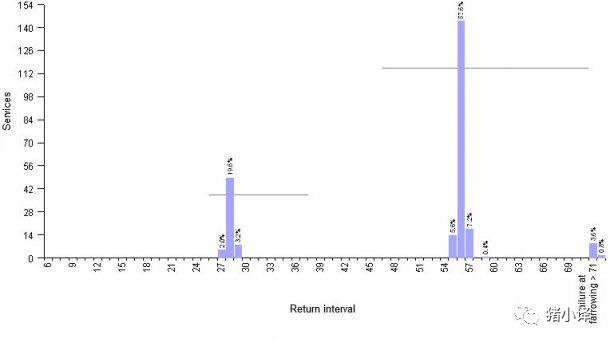
本文讨论4周批生产系统(4WBF),包括法国在内的一些国家的小型猪场(存栏250头母猪)中很常见。分析将基于与3周批生产(3WBF)的比较。
This article discusses 4-week batch farrowing (4WBF), very common in small farms (250 sows) in some other countries, including France. Analysis will be based on a comparison with 3-week batch farrowing (3WBF).
在当今养猪业中,小型猪场(存栏至500头母猪)使用超过1周批次的分娩系统是非常普遍的。这些分批分娩系统的优点包括:更好地组织安排猪场工作,以及由于更大的断奶批次而生产的健康猪只和转栏(运输)优势,时间间隔更长且年龄差异更大。在西班牙最常见的管理是3周批管理系统,平均哺乳期约28天,但有几种不同类型的分娩产仔系统。
It is very common, in today's swine industry, to use more-than-1-week batch farrowing systems in small farms (up to 500 productive sows). The advantages on those batch farrowing systems include: better organization of farm tasks, as well as both health and logistic advantages due to the production of larger weaning batches, farther apart in time and with a bigger age difference amongst them. The most common management in Spain is 3-week batch farrowing, with an average lactation length of about 28 days, but there are several different types of batch farrowing systems.
哺乳期Lactation length
3周批次生产系统需要28天的哺乳期,而4周批次仅需21天。显然这是一个重要的变化,在作出决定前,需评估下不同批次化管理的优缺点。
While 3WBF requires a lactation length of 28 days, 4WBF forces a length of 21 days. Obviously, it is an important change, which advantages and disadvantages have to be assessed before making a decision.
批次大小Batch size
4周批母猪分为5批,比3周批生产系统少2个批次,故每批数量多。举例来说,一个存栏250头母猪的猪场在4周批生产系统中,每批约有50头分娩,而3周批约有36头分娩。断奶仔猪之间的年龄差异是4周批为4周,3周批为3周。4周批生产的批量更大和年龄差异更大而生产的健康猪只和转栏(运输))优势。例如在自繁自养猪场猪只大批量生产,意味着运输次数减少,从而显着改善生物安全等方面。
4 Week BF results in 5 batches of sows, 2 batches less than 3WBF systems, therefore batch size is bigger. As an example, a 250-sow farm would have about 50 farrowings per batch in 4WBF, and about 36 in 3WBF. Age difference between weaner batches is 4 weeks for 4WBF and three weeks for 3WBF. Bigger batch size and wider age difference between batches of 4WBF will become an advantage in logistics and health terms. As an example, in farrow to finish farms bigger batches would mean sharing fewer slaughter trucks, therefore significantly improving areas such as biosecurity.
工作计划Task planning
下表显示了两种类型管理的每周主要的工作计划(配种,M,分娩,F和断奶,W)。
The Table below shows weekly planning of main tasks (mating, M, farrowing, F, and weaning, W) for both types of management.
表1每周工作计划Table 1.- Weekly task planning.

工作任务在3周批中分布更广泛。然而在4周批生产中看上去是一个劣势的确可以是一个优势:2周可免除最重要的任务(配种,分娩和断奶),可以帮助更好地安排其他活动,如其他农业劳动,安排假期,培训,维修工作,一般清洁等...
Tasks are more widely distributed in 3WBF. However, what appears to be a disadvantage in 4WBF can be an advantage: having 2 weeks free of the most important tasks (matings, farrowings and weaning), can help to better organize other activities such as agricultural tasks, holidays, training, maintenance work, general cleaning, etc...
设施利用最优化
Optimization of facilities
如果我们只考虑母猪设施,不考虑断奶或育肥设施,4周批的一个显著优点是分娩栏的最大化利用:由于每4周分娩一次,哺乳期为3周,所以只需要分娩栏配合一个分娩批次。按照上面的例子,一个250头母猪的猪场,4 周批需要50-55个分娩栏,而3周批则需要75-80个分娩栏。另一方面,4周批次生产需要更多的非生产周期母猪设施,因大批量的断奶母猪(我们必须记住,分娩栏比非生产周期母猪设施更昂贵)
If we only consider sow accommodation, without considering weaner or finisher facilities, a significant advantage of 4WBF is theoptimum use of farrowing crates: since farrowings take place every 4 weeks, and lactation length is 3 weeks, it only requires farrowing crates to fit one farrowing batch. Following the example above, a 250-sow farm would need 50-55 farrowing crates for 4WBF, instead of 75-80 crates needed if working with 3 week BF. On the other hand, 4WBF would require more dry sow accommodation, since larger batches are weaned, (although we must remember that farrowing crates are always more expensive than dry sow accommodation)
Table 2.- Farrowing room occupancy weekly planner, E:entry; F: Farrowing: L: lactation; W: Weaning
表2.-分娩舍每周计划表,E:转入; F:分娩:L:哺乳; W:断奶

保持批量大小Maintaining bacth size
另一方面,保持批次完整性是4周批的主要缺点,因为大多数母猪返情是定期的,故会脱离批次。这个事实迫使猪场在发现返情母猪发情时不能配种。猪场必须通过使用荷尔蒙做同期发情处理,并在下一批次(56天后)或跳过几次情期,直至其发情组成一批(约84天)。这涉及非生产天数的增加以及由于激素使用而造成的额外成本。显然,当妊娠结果较好,繁殖障碍较少时,这些负面影响会较小。
On the other hand, keeping batch integrity is the main drawback of 4WBF, since most returns are regular and would, therefore, fall out of batch. This fact forces the farmer not to service those returns when they are found to be on heat. They must either synchronise them by using hormones and mating them at next batch (after 56 days) or skip several oestrus until their heat fits with a batch ( 84 day approx). This involves an important increase of non-productive days and extra cost due to hormone use. Obviously, when gestation results are better, with fewer reproductive losses, these negative effects will be smaller.
图1.- 4周批次生产猪场的例子:使用激素规划返情母猪配种。平均返情间隔51.6天
Graphic 1.- Example of 4WBF farm: planning of return sow mating by use of hormones. Average return interval 51,6 days

使用代乳母猪Use of nurse sows
严格实施分批分娩使代乳母猪的使用变得困难,特别是在采用4周批次生产时,由于分娩舍中的大部分仔猪几乎是同龄的。一个可以使用代乳母猪的策略是有一个小的分娩舍,把配种母猪用作代乳母猪。此设施也允许一些脱离批次的母猪配种,尽管这可能会产生负面影响(断奶批次不严格按日龄分离,批次不同)。
Strict implementation of batch farrowing makes it difficult to use nurse sows, especially when working with 4WBF, since most piglets present at the farrowing house are nearly the same age. A strategy that would allow the use of nurse sows is to have a small farrowing house to place sows mated out of batch that could be used as nurse sows. This facility would also allow mating of some females that fall out of batch, although it could lead to negative effects (not strict separation by age of weaning batches, more heterogeneous batches).
总之,4周批生产是小型猪场可以考虑的选择,其与传统的3周批生产系统相比有不同之处,在每种情况下都应该进行评估。
As a conclusion, 4-week batch farrowing is a feasible option for small farms to be considered, although there are differences when compared to more traditional 3-week batch farrowing systems that should be assessed in every situation.
非瘟时期,批次化生产除了有更好的经济表现外, 更少频次的接触母猪与仔猪,将更利于非瘟防控。
作者:M.A. de Andrés、Elena Vizcaíno、María Aparicio、Carlos Pieiro
新闻检索
 推荐阅读
推荐阅读

福建傲农生物科技集团股份有限公司,地址: 福建省漳州市芗城区石亭镇兴亭路和宝莲路交叉处, AONONG
© 2011-2020 All rights reserved 闽ICP备11012412号-1